O duyguyu biliriz. Siteniz çöktüğünde ve nedenini bilmediğiniz o batma anı. Bu en yaygın WordPress hatalarından biridir, ancak aynı zamanda en gizemli olanlardan biridir. Size sorunun ne olduğunu söylemez, sadece bir şeylerin bozuk olduğunu söyler.
İyi haber ne mi? Neredeyse her zaman düzeltilebilir. Sayısız müşteriye yardımcı olduğumuz için bu hatayla oldukça fazla karşılaştık.
Bu kılavuzda, sitenizi tekrar çalışır hale getirmek için tam adımlarla size yol göstereceğiz. Sadece takip edin ve her şeyi kısa sürede yeniden çalışır hale getirin.
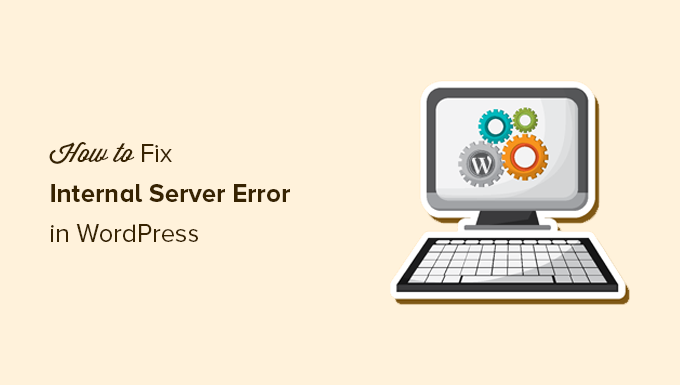
İşte bu makalede ele alacağımız konulara hızlı bir genel bakış:
- What Is the 500 Internal Server Error?
- What Causes the Internal Server Error in WordPress?
- Fixing the 500 Internal Server Error in WordPress
- Clear WordPress and Browser Cache
- Checking for Corrupt .htaccess File
- Increasing the PHP Memory Limit
- Deactivate All WordPress Plugins
- Switch to a Default WordPress Theme
- Re-Uploading Core Files
- Enable Debug Logs in WordPress
- Ask Your Hosting Provider
- Video Tutorial
500 Dahili Sunucu Hatası Nedir?
500 Dahili Sunucu Hatası, anahtarı olmayan kilitli bir kapı gibidir. Bir şeylerin yanlış gittiğini bilirsiniz ama ne olduğunu açıklayan bir not yoktur.
Bu hata sadece bir WordPress sorunu değildir. Sunucu nasıl başa çıkacağını bilmediği bir sorunla karşılaştığında herhangi bir web sitesinde görünebilir.
Mesajdaki “500” bir HTTP durum kodudur. Eğer araştırırsanız, belirsiz bir tanım bulacaksınız:
“500 Internal Server Error yanıt kodu, sunucunun isteği yerine getirmesini engelleyen beklenmedik bir durumla karşılaştığını gösterir.”
Bu pek yardımcı olmuyor, değil mi? Bu, sunucunun “Bir şey bozuldu ama ne olduğundan emin değilim” deme şekli.
Bu hatanın nasıl görüneceği barındırma kurulumunuza ve web tarayıcınıza bağlıdır. İşte bir Apache sunucusunda nasıl göründüğüne dair bir örnek:
Siteniz Nginx üzerinde çalışıyorsa, biraz farklı görünebilir. Ve Google Chrome düzgün bir hata sayfası yükleyemezse, buna benzer bir şey görürsünüz:
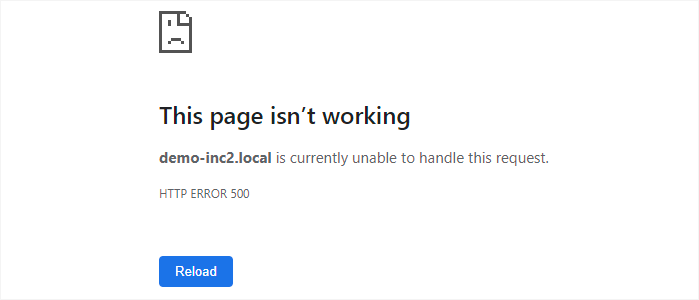
Yeni başlayanlar için bu durum bunaltıcı olabilir. Neyin yanlış gittiğini veya nasıl düzeltileceğini söyleyen bir mesaj yoktur.
Bu, bir tamirciden neyin bozuk olduğunu söylemeden arabanızı tamir etmesini istemeye benzer. Sorunu bulana kadar farklı parçaları kontrol etmeleri gerekecektir.
Deneyimlerimize göre, sorunu çözmenin en iyi yolu adım adım ilerlemektir. Sitenizi tekrar çalışır hale getirebilmeniz için en yaygın nedenler ve çözümler konusunda size yol göstereceğiz.
İsteğe Bağlı WordPress Desteği ile Her Zaman Uzman Yardımı Alın!
Dahili sunucu hatasıyla uğraşmak sinir bozucu olabilir. İsteğe Bağlı WordPress Desteğimiz, teknik sorunları hızlı ve etkili bir şekilde çözmenize yardımcı olmak için burada.
- İsteğe bağlı uzman desteği için tek seferlik ödeme
- Hızlı geri dönüş süreleri
- 7/24 ulaşılabilir
WordPress’te Dahili Sunucu Hatasına Ne Sebep Olur?
WordPress’teki dahili sunucu hatası, eksik parçaları olan bir yapboz gibidir. Bir şeylerin yanlış gittiğini bilirsiniz, ancak hata mesajı size sorunun tam olarak nerede olduğunu söylemez.
Deneyimlerimize göre, en yaygın suçlu bozuk bir .htaccess dosyasıdır. Bazen de yanlış davranan bir eklenti veya kurulumunuzla uyumlu çalışmayan bir temadır.
Diğer zamanlarda, siteniz PHP bellek sınırına ulaşarak WordPress’in çökmesine neden olabilir. Bozuk çekirdek dosyaları da bu hatayı tetikleyebilir ve sizi uyarı vermeden kilitli bırakabilir.
Bazı durumlarda, hata yalnızca WordPress yönetici alanına erişmeye çalışırken ortaya çıkar, sitenizin geri kalanı ise sorunsuz çalışır. Bu, misafirler hala arka kapıdan girebilirken kendi evinizin dışında kilitli kalmak gibidir.
Bu hatayı zor yapan şey, genellikle WordPress düzgün bir şekilde yüklenmeden önce meydana gelmesidir. Bu, sunucunun neyin yanlış gittiğini açıklamak için yeterli ayrıntı toplayamayacağı anlamına gelir.
WordPress’in perde arkasında nasıl çalıştığına daha derinlemesine bakmak istiyorsanız, WordPress’ in kaputun altında nasıl çalıştığına dair kılavuzumuza göz atın.
Şimdi, sitenizi tekrar çalışır hale getirmek için sorun giderme adımlarını inceleyelim.
WordPress’te 500 Dahili Sunucu Hatasını Düzeltme
Sorun gidermeye başlamadan önce, web sitenizin eksiksiz bir WordPress yedeğinin elinizde olduğundan emin olun.
WordPress yönetici alanına erişiminiz varsa, web sitenizin tam bir yedeğini oluşturmak için bir WordPress yedekleme eklentisi kullanabilirsiniz.
Bunu halletmek için Duplicator kullanmanızı öneririz. Yalnızca web sitenizi hızlı bir şekilde yedeklemenize yardımcı olmakla kalmaz, aynı zamanda yedeklerinizi bulutta depolayabilir ve en önemlisi, web sitenizi yedekten geri yükleyebilirsiniz.
Öte yandan, WordPress yönetici alanına erişiminiz yoksa, phpMyAdmin ve bir FTP istemcisi kullanarak manuel olarak bir WordPress yedeklemesi oluşturabilirsiniz.
Bundan sonra, web sitenizdeki dahili sunucu hatasını gidermek ve düzeltmek için aşağıdaki adımları takip edebilirsiniz.
WordPress ve Tarayıcı Önbelleğini Temizleyin
Tarayıcılar ve WordPress önbellek eklentileriniz bazen yanlışlıkla bir hata sayfasının önbelleğe alınmış bir kopyasını saklayabilir.
Bunu düzeltmenin en kolay yolu, öncelikle tarayıcı önbelleğinizi temizlemektir.
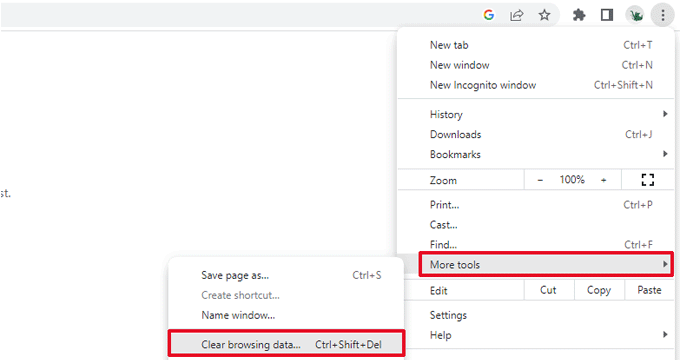
Bundan sonra, web sitenizin WordPress yönetici alanına erişiminiz varsa, önbellek eklentinizin ayarlar sayfasını ziyaret ederek WordPress önbelleğini boşaltabilirsiniz.
Ayrıntılar için WordPress önbelleğinin nasıl temizleneceğine ilişkin eğitimimize bakın.
Bozuk .htaccess Dosyasını Kontrol Etme
.htaccess dosyası, WordPress tarafından yönlendirmeleri ayarlamak için kullanılan bir sunucu yapılandırma dosyasıdır.
Dahili sunucu hatasının en yaygın nedenlerinden biri bozuk .htaccess dosyasıdır.
Bunu düzeltmenin en kolay yolu, WordPress yönetici alanındaki Ayarlar ” Kalıcı Bağlantılar sayfasını ziyaret etmek ve ardından herhangi bir değişiklik yapmadan ‘Değişiklikleri Kaydet’ düğmesine tıklamaktır.
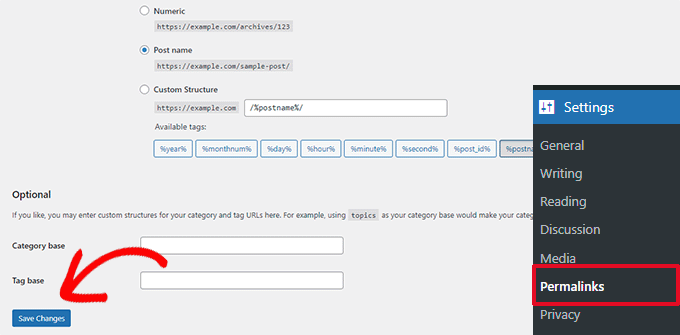
WordPress şimdi .htaccess dosyanızı güncellemeye veya yeni bir tane oluşturmaya çalışacaktır. Bunun dahili sunucu hatasını çözüp çözmediğini görmek için artık web sitenizi ziyaret edebilirsiniz.
Hatayı hala görebiliyorsanız, WordPress’in .htaccess dosyasını oluşturabildiğinden veya dosyaya yazabildiğinden emin olmanız gerekir.
Bazen dosya ve dizin izinleri nedeniyle WordPress .htaccess dosyanızı oluşturamayabilir veya dosyanıza yazamayabilir.
Şimdi .htaccess dosyasını manuel olarak değiştirmeyi deneyebilirsiniz. Öncelikle, hosting hesabı kontrol paneliniz altındaki FTP veya Dosya Yöneticisi uygulamasını kullanarak web sitenize giriş yapmanız gerekir.
Ardından, ana.htaccess dosyanızı.htaccess_old gibi bir adla yeniden adlandırmanız gerekir. Bu, dosyayı yedek olarak tutmanızı sağlar, ancak WordPress onu tanımayacaktır.
.htaccess dosyasını yeniden adlandırmak için, hosting hesabınızın cPanel panosundaki FTP veya Dosya Yöneticisi uygulamasını kullanarak sitenizde oturum açmanız gerekecektir.
Bağlandıktan sonra, .htaccess dosyası wp-content, wp-admin ve wp-includes gibi klasörleri göreceğiniz aynı dizinde yer alacaktır.
Sadece .htaccess dosyasına sağ tıklayın ve .htaccess_old olarak yeniden adlandırın.
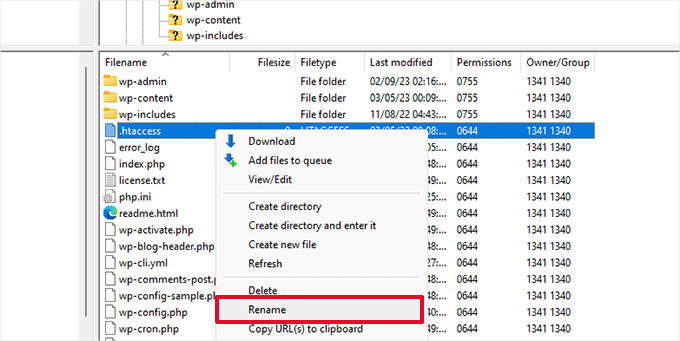
Ardından, yeni bir .htaccess dosyası oluşturmanız gerekir.
Sitenizin kök klasörüne sağ tıklayın ve ardından FTP istemcinizde veya Dosya Yöneticisi uygulamasında ‘Yeni dosya oluştur’ seçeneğini seçin.
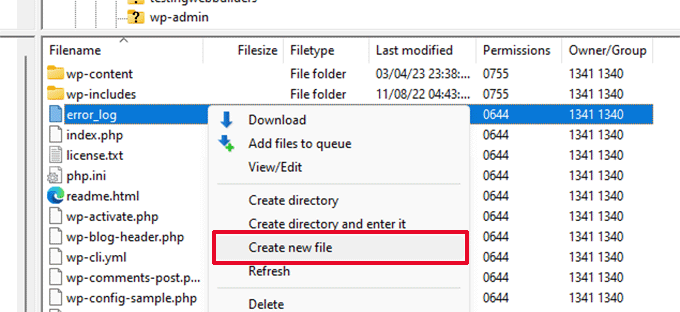
Bu yeni dosyaya .htaccess adını verin ve kaydetmek için ‘Tamam’a tıklayın.
Şimdi, bu .htaccess dosyası şu anda boş ve buna varsayılan WordPress yeniden yazma kurallarını eklemeniz gerekiyor.
Dosyaya sağ tıklayın ve ardından FTP istemcinizde veya Dosya Yöneticisi uygulamanızda ‘Görüntüle/Düzenle’yi seçin.
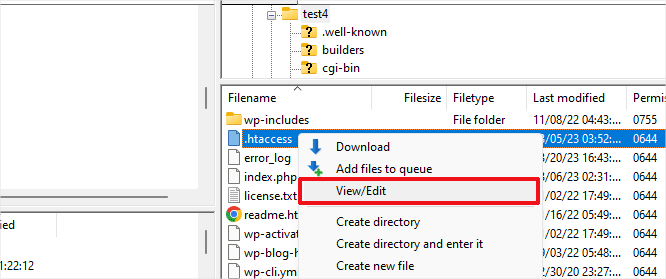
Boş dosya Notepad veya TextEdit gibi bir düz metin düzenleyicide açılacaktır.
Şimdi, aşağıdaki kodu kopyalayıp içine yapıştırmanız gerekir:
1 2 3 4 5 6 7 8 9 10 | # BEGIN WordPress<IfModule mod_rewrite.c>RewriteEngine OnRewriteBase /RewriteRule ^index.php$ - [L]RewriteCond %{REQUEST_FILENAME} !-fRewriteCond %{REQUEST_FILENAME} !-dRewriteRule . /index.php [L]</IfModule># END WordPress |
Bu kod WordPress tarafından kullanılan varsayılan kural setidir. Değişikliklerinizi kaydetmeyi ve dosyayı sunucuya geri yüklemeyi unutmayın.
Bunun dahili sunucu hatasını çözüp çözmediğini görmek için artık web sitenizi ziyaret edebilirsiniz.
Eğer öyleyse, dahili sunucu hatasını düzelttiğiniz için kendinizi tebrik edin.
Önemli: Diğer işlemlere geçmeden önce, WordPress yönetici alanındaki Ayarlar ” Kalıcı Bağlantılar sayfasına gittiğinizden ve herhangi bir değişiklik yapmadan Kaydet düğmesine tıkladığınızdan emin olun. Bu, yazı sayfalarınızın 404 hatası döndürmemesini sağlamak için .htaccess dosyasını sizin için uygun yeniden yazma kuralları ile yeniden oluşturacaktır.
Bozuk .htaccess dosyası çözümünü kontrol etmek sizin için işe yaramadıysa, bu makaleyi okumaya devam etmeniz gerekir.
PHP Bellek Sınırını Yükseltme
Bazen, bir komut dosyası PHP bellek sınırının tamamını tüketirse dahili sunucu hatası oluşabilir.
PHP bellek sınırını artırmanın en kolay yolu wp-config.php dosyasını düzenlemektir. Eğer yeni başlayan biriyseniz bunu yaparken dikkatli olun. WordPress çekirdek dosyalarındaki küçük hatalar bile sitenizi bozabileceğinden bu talimatları dikkatle izlemeniz gerekir.
Başlamak için, bir FTP istemcisi veya hosting hesabı kontrol paneliniz altındaki Dosya Yöneticisi uygulamasını kullanarak WordPress web sitenize bağlanmanız yeterlidir.
Wp-config.php dosyasını web sitenizin ana klasörünün içinde bulacaksınız. Üzerine sağ tıklayın ve ‘İndir’i seçin. Bu, bir şeylerin yanlış gitmesi durumunda bir dosya yedeğinizin olmasını sağlayacaktır.
Bunu kaydettiğinizde, üzerine sağ tıklayıp ‘Görüntüle/Düzenle’yi seçebilirsiniz.
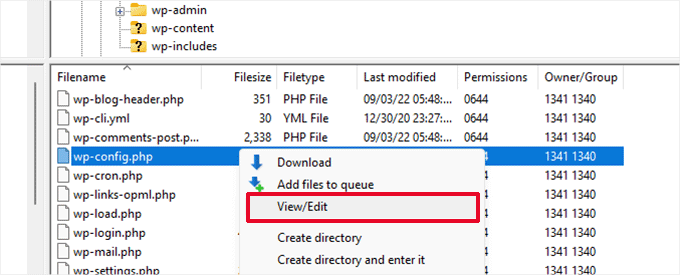
wp-config.php dosyasının içine, ‘Hepsi bu kadar, düzenlemeyi bırakın!’ yazan satırın hemen üstüne aşağıdaki kodu eklemeniz gerekir. Mutlu yayınlar’:
1 | define( 'WP_MEMORY_LIMIT', '256M' ); |
Daha fazla ayrıntı için WordPress’te PHP bellek sınırının nasıl artırılacağına ilişkin eğitimimize bakın.
Not: 256M sorunu çözmezse, 512M’ye çıkarmayı deneyin.
Dahili sunucu hatasını yalnızca WordPress yöneticinize giriş yapmaya çalıştığınızda veya wp-admin’inize bir resim yüklediğinizde görüyorsanız, aşağıdaki adımları izleyerek bellek sınırını artırmalısınız:
- Bilgisayarınızda boş bir metin dosyası oluşturun ve php.ini olarak adlandırın
- Bu kodu buraya yapıştırın: memory=256MB
- Dosyayı kaydedin
- FTP kullanarak /wp-admin/ klasörünüze yükleyin
Bellek sınırını artırmak sorunu sizin için çözdüyse, sorunu yalnızca geçici olarak çözdünüz demektir. Hala bellek limitinizi tüketen nedeni bulmanız gerekir.
Bu, kötü kodlanmış bir eklenti veya hatta bir tema işlevi olabilir. Tam tanılamayı bulmanıza yardımcı olması için WordPress web barındırma şirketinizden sunucu günlüklerine bakmasını istemenizi şiddetle tavsiye ederiz.
PHP bellek sınırını artırmak sorunu sizin için çözmediyse, daha fazla sorun gidermeye ihtiyacınız var demektir.
Tüm WordPress Eklentilerini Devre Dışı Bırakın
Yukarıdaki çözümlerden hiçbiri sizin için işe yaramadıysa, bu hata büyük olasılıkla web sitenizde yüklü olan belirli bir eklentiden kaynaklanmaktadır.
Birbiriyle iyi oynamayan eklentilerin bir kombinasyonu olması da mümkündür.
Web sitenizin WordPress yönetici alanına erişebiliyorsanız, eklentiler sayfasına gidebilir ve tüm WordPress eklentilerini devre dışı bırakabilirsiniz.
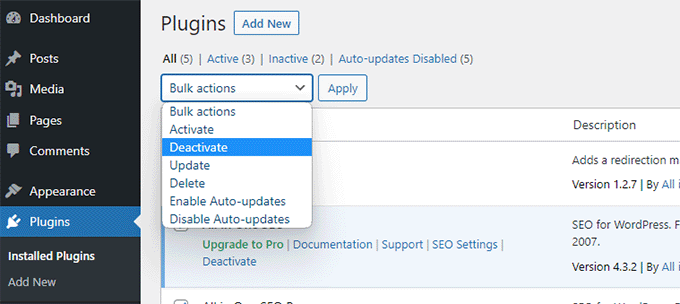
Ancak, WordPress yönetici alanına erişemiyorsanız, FTP kullanarak tüm WordPress eklentilerini devre dışı bırakabilirsiniz.
Bir FTP istemcisi veya barındırma hesabı kontrol panelinizdeki dosya yöneticisi uygulamasını kullanarak WordPress web sitenize bağlanmanız yeterlidir.
Bağlandıktan sonra /wp-content/ klasörüne gidin ve plugins klasörünü plugins.deactivated olarak yeniden adlandırın.
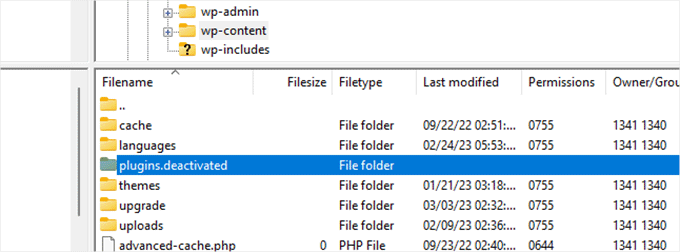
WordPress eklentileri plugins klasöründe arar. Eklentiler klasörü bulunamazsa, tüm eklentileri otomatik olarak devre dışı bırakacaktır.
Şimdi web sitenizdeki dahili sunucu hatasının çözülüp çözülmediğini görmek için web sitenizi ziyaret etmeyi deneyebilirsiniz.
Tüm eklentilerinizi geri yüklemek için ‘plugins.deactivated’ klasörünü tekrar plugins olarak yeniden adlandırabilirsiniz.
Eklentileriniz şimdi geri yüklenecek, ancak yine de devre dışı bırakılacaklar.
Artık eklentileri tek tek etkinleştirebilir ve hangi eklentinin dahili sunucu hatasına neden olduğunu bulmak için web sitenizi ziyaret edebilirsiniz.
Daha fazla ayrıntı için, wp-admin olmadan tüm WordPress eklentilerinin nasıl devre dışı bırakılacağına ilişkin kılavuzumuza bakın.
Tüm eklentileri devre dışı bırakmak web sitenizdeki dahili sunucu hatasını düzeltmediyse, okumaya devam edin.
Varsayılan WordPress Temasına Geçin
Dahili sunucu hatasının olası bir nedeni WordPress temanızdaki bazı kodlar olabilir.
Durumun böyle olup olmadığını belirlemek için temanızı varsayılan bir WordPress temasına değiştirmeniz gerekir.
WordPress yönetici alanına erişiminiz varsa, Görünüm ” Temalar sayfasına gidin. Varsayılan bir tema zaten yüklüyse, temayı değiştirmek için Etkinleştir düğmesine tıklayabilirsiniz.
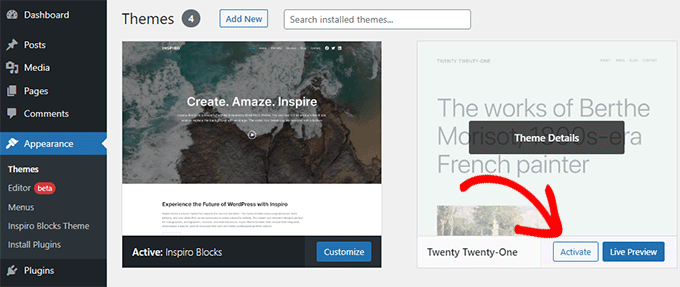
Yüklü bir varsayılan temanız yoksa, üstteki ‘Yeni Ekle’ düğmesine tıklayabilir ve varsayılan bir tema yükleyebilirsiniz (Twenty Twenty-Three, Twenty Twenty-Two vb.).
WordPress yönetici alanına erişiminiz yoksa, yine de varsayılan bir temaya geçebilirsiniz.
Bir FTP istemcisi kullanarak WordPress web sitenize bağlanın ve /wp-content/ klasörüne gidin.
Temalar klasörünü seçmek için sağ tıklayın ve yedek olarak bilgisayarınıza indirin.
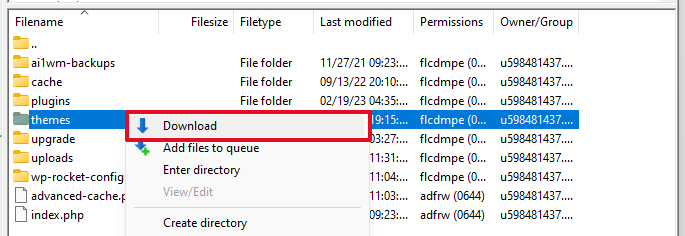
Ardından, temalar klasörünü web sitenizden silmeniz gerekir. Silindikten sonra, devam edin ve yeni bir themes klasörü oluşturun.
Yeni temalar klasörünüz tamamen boş olacaktır, bu da şu anda yüklü herhangi bir WordPress temanız olmadığı anlamına gelir.
Ardından, WordPress temalar dizinini ziyaret etmeniz ve bilgisayarınıza varsayılan bir WordPress teması indirmeniz gerekir.
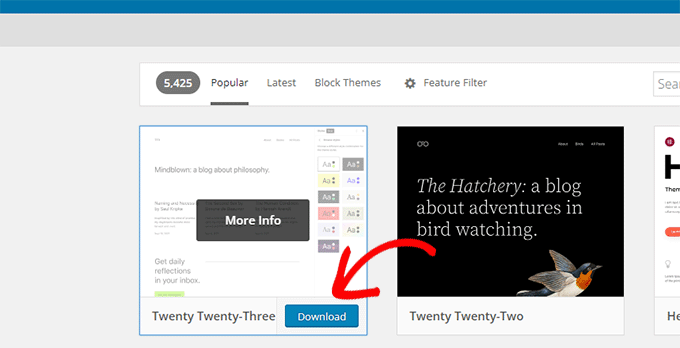
Tarayıcınız daha sonra temayı bir zip dosyası olarak bilgisayarınıza indirecektir.
Dosyayı bilgisayarınızda bulun ve ardından açın. Windows kullanıcıları dosyaya sağ tıklayıp ‘Tümünü Çıkar’ı seçerek dosyayı açabilirler. Mac kullanıcıları zip dosyasına çift tıklayarak çıkartabilirler.
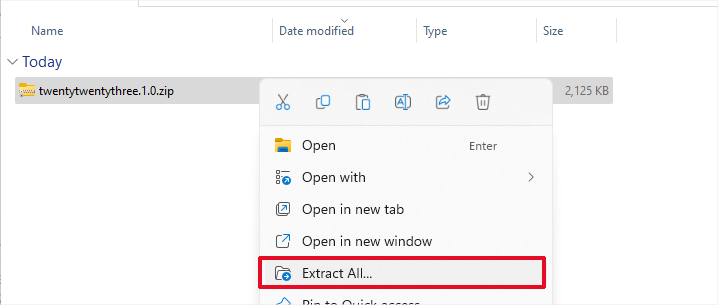
Şimdi WordPress temanızı içeren bir klasör göreceksiniz.
FTP istemcinize veya Dosya Yöneticinize geri dönün ve bu klasörü boş temalar klasörüne yükleyin.
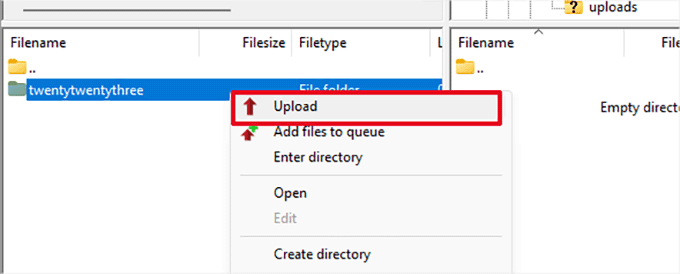
Yüklendikten sonra WordPress otomatik olarak varsayılan temayı kullanmaya başlayacaktır.
Artık dahili sunucu hatasının çözülüp çözülmediğini görmek için web sitenizi ziyaret edebilirsiniz.
Bu işe yaramazsa, WordPress temalarınızı yedekten yeniden yükleyebilir veya kullandığınız temaya geri dönebilirsiniz.
Endişelenmeyin. Hatayı düzeltmek için hala yapabileceğiniz birkaç şey daha var.
Çekirdek Dosyaların Yeniden Yüklenmesi
Eklenti ve tema seçenekleri dahili sunucu hatasını düzeltmediyse, /wp-admin/ ve /wp-includes/ klasörlerini yeni bir WordPress kurulumundan yeniden yüklemeye değer.
Bu, bilgilerinizin hiçbirini KALDIRMAYACAKTIR, ancak herhangi bir dosyanın bozulması durumunda sorunu çözebilir.
İlk olarak, WordPress.org web sitesini ziyaret etmeniz ve ‘İndir’ düğmesine tıklamanız gerekecektir.
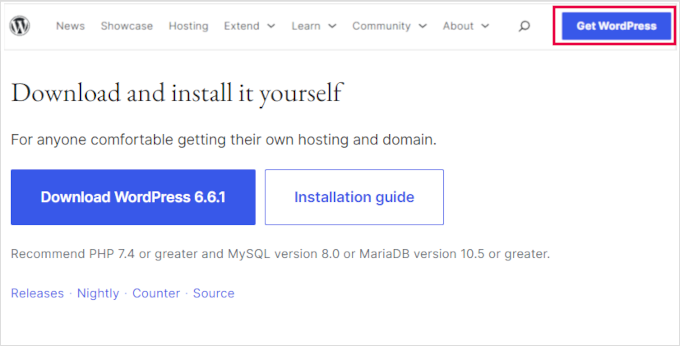
Bu, WordPress zip dosyasını bilgisayarınıza indirecektir.
Devam edin ve zip dosyasını çıkarın. İçinde bir wordpress klasörü bulacaksınız.

Ardından, bir FTP istemcisi kullanarak WordPress web sitenize bağlanmanız gerekir.
Bağlandıktan sonra, web sitenizin kök klasörüne gidin. Bu, içinde wp-admin, wp-includes ve wp-content klasörlerinin bulunduğu klasördür.
Sol sütunda, bilgisayarınızdaki WordPress klasörünü açın.
Şimdi wordpress klasörünün içindeki tüm dosyaları seçmeniz ve web sitenize yüklemeniz gerekir.
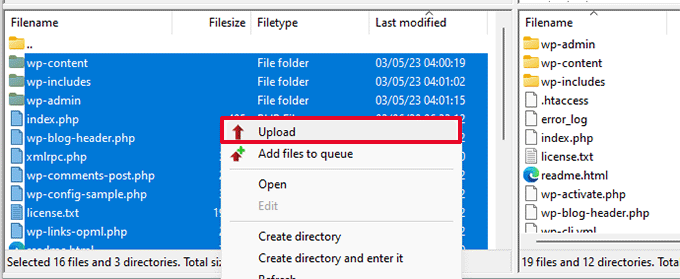
FTP istemciniz şimdi bu klasörleri sunucunuza aktaracaktır.
Size dosyaların üzerine yazmak isteyip istemediğinizi soracaktır. ‘Üzerine yaz’ı seçin, ardından ‘Bu eylemi her zaman kullan’ı seçin ve ‘Yalnızca geçerli kuyruğa uygula’ onay kutusunu işaretleyin.
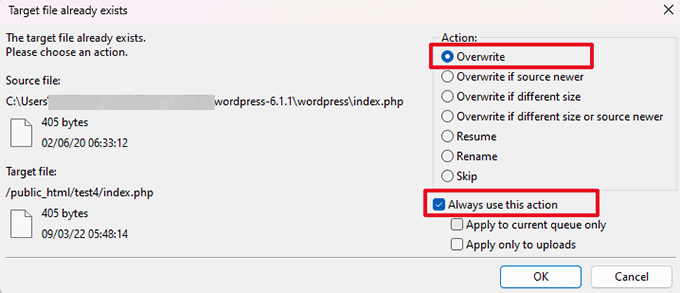
FTP istemciniz artık eski WordPress dosyalarınızı yeni, taze kopyalarla değiştirecektir.
WordPress dosyalarınız bozulmuşsa, bu adım dahili sunucu hatasını sizin için düzeltecektir.
WordPress’te Hata Ayıklama Günlüklerini Etkinleştirme
WordPress, hata ayıklama için günlük tutmak üzere yerleşik bir sistemle birlikte gelir.
WP Hata Ay ıklama eklentisini kullanarak bunu açabilirsiniz. Daha fazla ayrıntı için WordPress eklentisi yükleme kılavuzumuza bakın.
Eklenti etkinleştirildiğinde, WordPress web sitenizde hata ayıklama günlüklerini açacaktır.
WordPress web sitenizin yönetici alanına erişiminiz yoksa, wp-config.php dosyanıza aşağıdaki kodu ekleyerek hata ayıklamayı açabilirsiniz:
1 2 | define( 'WP_DEBUG', true);define( 'WP_DEBUG_LOG', true); |
Hata ayıklama günlüklerini açtıktan sonra, bir FTP istemcisi kullanarak ve /wp-content/ klasörüne giderek bunları görüntüleyebilirsiniz.
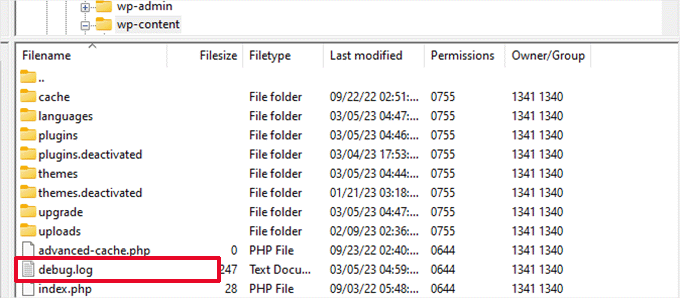
Hata ayıklama günlük dosyasını bir metin düzenleyicide açabilirsiniz ve size web sitenizde meydana gelen hataların ve uyarıların bir listesini gösterecektir.
Bazı hatalar ve uyarılar, düzeltilmesi gerekmeyen zararsız olaylar olabilir. Ancak, web sitenizde bir dahili sunucu hatası görüyorsanız, bunlar sizi doğru yöne yönlendirebilir.
Hosting Sağlayıcınıza Sorun
Tüm yöntemler web sitenizdeki dahili sunucu hatasını düzeltmede başarısız olursa, daha fazla yardım almanın zamanı gelmiş demektir.
Web barındırma destek ekibinizle iletişime geçin; sunucu günlüklerini kontrol edebilir ve hatanın temel nedenini bulabilirler.
Sorun gidermeye kendi başınıza devam etmek istiyorsanız, yeni başlayanlar için nihai WordPress sorun giderme kılavuzumuza bakın.
Video Eğitimi
If you liked this article, then please subscribe to our YouTube Channel for WordPress video tutorials. You can also find us on Twitter and Facebook.





Ryan
I get the same Internal Server Error happening every couple of weeks now.
Each time it’s an issue with the .htaccess file, it’s an easy fix to get the site up and running thanks to the info you provided above but is there anything I can do that will prevent the error re-occurring?
Thanks.
carl
Thanks dude, you saved my beans and saved me from some real hassle. Super Kudos
Anil
Any advice for intermittent 500 errors?
WHITEFEATHER HUNTER
I tried renaming the htaccess file to htaccess_old like you said, and it disappeared! Now I get 404 errors every time I try to load the website’s various pages.
My original problem was indeed the plugins – deactivating them brought my website back online. However, NOW I have this 404 problem.
Also, I cannot find a Settings option in FileZilla – can you please help?
Thanks!
Chad Warren
The reason you are receiving 404 errors is because you have renamed your .htaccess file The .htaccess file contains the rewrite code to make your links pretty. ie: http://www.example.com/about instead of http://www.example.com/?p=259
The simplest way to correct this is to log into the WP admin and go to Settings >> Permalinks Make sure you have the proper permalink option selected and then Save. This will recreate the the proper rewrite peramaters within .htaccess
Previsha
Thank you so much, Changing the .htaccess file worked.
Norman Fellows
Hi Editorial Staff!
Checking for the corrupt .htaccess file solution worked for me. Thank you.
I had been doing a lot of work on the site including updating Jetpack. Not sure what the culprit was but I was completely locked out…
Matthew
Pretty useful! Good job Syed.
aiyeboy
thanks but whenever i rename the htaccess the site comes up and goes down after 1 minute again and this as been keeping my website offline for days now….helpppp
WPBeginner Support
Why would you rename htaccess file? Delete any .htaccess file you have renamed including the original .htaccess file.
Admin
aiyeboy
you mean i should delete my htaccess file , but it automatically comes back.
WPBeginner Support
Yes it does, if your .htaccess file had some problem then deleting it should have solved it.
Owolabi
You Guys are great ! I always find solution to my problems here. once again tank you and keep the good work up.
Cheers!
pushkar
Nothing of the above worked. It seems the problem was with my wordpress Theme. I changed to another theme and the website is back to normal. This link shows how to change the theme without a working admin http://wordpress.shadowlantern.com/change-wordpress-theme-in-phpmyadmin/
WPBeginner Support
You can also change your theme by deleting all themes and only leaving the theme that you want to use in /wp-content/themes directory.
Admin
viksit singh
Really work’s thanks dude
It’s good Nice post Having a great knowledge about that…
Please Help i want a hosting service which is cheep giv me domain and Support
Thanks
Jayson T Cote
I wanted to add another situation that may cause Internal Server errors and can be easily remedied.
Check your php.ini file usually located in your root directory on your web hosting server.
I recently updated our server from PHP version 5.3.x to 5.4.x The update changed a few PHP options which were set differently in the local php.ini file. We made the same changes to the website’s local php.ini file as we did on the server and eliminated the Internal Server error.
Take caution, you can try renaming the php.ini file (php.ini.old) and reload your website to see if it makes a difference. Looking at the servers error logs will determine the exact PHP option in question that will need to be edited in your local php.ini file.
Bill Cruz
Thank you based god! renaming my .htaccess file and forcing a new one to be created resolved my blank webpage! I reset my mySQL database password, and updated the password on the wp-config.php file, but that still didn’t fix it, but this method did. Thanks.
Mikkel Lindblom
Thank you! Allways remember to check the .htaccess file
Mert Can
Hi,
I would like to ask you, how can I edit this error file (Internal Server Error)? Because it’s showing there my e-mail address. I am using linux Debian 7.
Thanks,
Best Regards,
Vyacheslav
Thank you for such a good article. This set of fixes is really handy to keep them all at fingertips.
My problem was the .htaccess file, but not the one in the root folder. It was rather the one in my /wp-admin folder. It came about that I protected /wp-admin folder with a password by means of host provider panel. It created the .htaccess file inside my /wp-admin folder. I also added some code into the file too.
Later I turned such a password protection of the folder off, so the code added by host provider panel itself was taken from the .htaccess file automatically. Meanwhile the code added by me still remained in the file. This piece of code caused the problem leading to Internal Server Error 500.
I just removed the .htaccess file due to its lack of necessity and it did the trick.
Vijay Sharma
Yes, it works for me to get the idea,
Solutions process I did
1. Define Php memory limit in “wp-config.php”
2. Deactivate all plugins
3. Update permalinks structure
4. Activate plugin one by one
NatalieDawn
Hey,
I have loads of problems with 503 error. My host told me it’s a problem with index.php file. Don’t know, how to solve it, HELP PLEASE! (I’m really desperate now ).
).
Asha Singh
Can i fix by uploading manual file or need to change any hosting file of ny site . because it has same issue several times at my end.
Thanks for info.
WPBeginner Support
Yes you can try uploading fresh copies of files to your server overwriting any existing files you might have. Please backup first.
Admin
Paul
yes I went through all the steps and as always my luck get the hardest, reinstalled via ftp job done!
Piers
Hooray, the .htaccess thing did the trick. Thanks so much for the valuable tips.
Yogesh
goooooooooooood…….Thanks bro
illahi
very informatice article i love it
Paul
None of the above worked for me – however, that’s because of what was causing my issue – so I thought they wouldn’t but tried them anyway.
However, I’ve dealt with heaps of WordPress sites so wasn’t too worried when I came across the issue.
For me, the error appeared when trying to access admin (the site itself loads) and it wasn’t the hosting as it was a site on my temp hosting platform and all other sites are fine.
The solution though is very simple (for what caused my issue),
I knew it happened just after changing the permalink structure, and I had accidently clicked the ‘Custom Structure’. (I was meant to use one of the others for this site). In my case this didn’t carry over to the htaccess file and removing the file didn’t work either.
Fix:
You’ll need access to phpMyAdmin. Locate the database used for your install. Locate the wp_options table and find the permalink_structure row (around 30 or so). You can edit the permalink there back to one of the others.
Next, edit the htaccess file with this to include the proper rewrite rules:
# BEGIN WordPress
RewriteEngine On
RewriteBase /
RewriteRule ^index\.php$ – [L]
RewriteCond %{REQUEST_FILENAME} !-f
RewriteCond %{REQUEST_FILENAME} !-d
RewriteRule . /index.php [L]
# END WordPress
After that clear your browser cache and refresh – also try getting in through a different browser.
This is one of many solutions – it works for me to reset permalinks.
khandy
Thank you!
The php.ini file saved me.
Have had this problem since introducing random header images to the Graphene theme. If this happens again later today (before I’ve got the error logs from my host) will this work again or do I need to up the number?
Bobbie Blakely
Hi Thank you for all of your help. I have a 500error, internal server error. I changed the plugin name to plugin.deactivate, that didn’t change the error. I tried to change the name for .htaccess file but it says that I can’t because the folder is empty. I have been having trouble for three days. I fix one thing and I get another error. Today I uploaded my wp backup files via FTP. Upon completion is when I got the 500 error. I would be grateful for any help. Thank you
Bobbie
WPBeginner Support
Bobbie, try this. Download your /wp-content/plugins and /wp-content/themes folders to your computer. Then delete the ones from your server and create new empty directories with the same names. From your website’s root directory delete your .htaccess file (You can later regenerate it again from settings -> permalinks.
Admin
poemaderoca
I disabled my plugins but didn’t help so decided to rename .htaccess file and this solved my problem. Thanks for the tutorial.
Stuart
Thank you. A real saver!! A corrupted .htaccess file was the answer
chris
seriously quick and painless! thanks!
Sascha
Thanks for this. Helped me a lot!
Tim
Thank you!. It was the .htaccess file that was the issue! The issue occurred after installing and activating the eCommerce shop.
I have not got a clue how renaming that file fixed it but it did! So thanks again!
Anton
Renaming the file .htaccess file worked. Thank you!!!!
Noerila
Wow.. great article !
its works for me..
thanks, man..
Chris
Thanks so much! Changed the name of the htaccess file and my 500 error disappeared!
Erik von Werlhof
Whew!
Had this problem pop up last night and thought I would be toast! I tried the solution as outlined above and it worked!
Much thanks,
Erik
Hossam
unfortunately NONE of the above worked for me, but I think I’ve another issue related to this O.o
my problem is: my website worked fine, but when trying to edit any plugin’s settings or adding a new data to it, here is the “page not found” appears to me!! NOTE that I’m using %postname% as permalinks, and when changed it to “default” then try again to edit any plugin, here is ” Internal Server Error” appears O.o
I’m confused, please help
thanks in advance
sebastian okelly
Excellent article. This is a really useful site for those who get lost in the Codex. Thanks.
Remington Phillips
Thank you! For me changing .htaccess to “.htaccess_old” worked.
Deckey
Hi,
I still have the problem with the Internal Error.
I’ve tried all your ways (PHPmemory, htaccess, plugins deactivated…) And still doesn’t work.
If I change htaccess, the Internal Error change message and there’s another:
“Not Found
The requested URL /about/ was not found on this server.
Additionally, a 404 Not Found error was encountered while trying to use an ErrorDocument to handle the request.
Apache Server at http://www.gdbautomotive.com Port 80″
How can I do?
Maybe is better for me to do the website again from the start?
Because I’ve done the passage from localhost to remote server…
Maybe if I restart everything immediately on the web is better and it will work?
I’m quiet desperate and I don’t know how to do other things….
Thank you so much,
Deckey
WPBeginner Support
Before doing that try the last option mentioned in the article and ask your web host for support.
Admin
Krishanu Choudhury
Hello i run A blog which has preety good alexa ranking.i currently use MArkabihost for hosting my website and use wordpress script.now i have decided to move to better hosting service so i would you suggest you a good hosting service whcih is cheap and better And i want to know the ways to backup from Markabi to current hosting service
WPBeginner Support
Take a look at our hosting guide, how to choose the best WordPress hosting.
Admin
payal
how can i solve error in which the web page show that contact adminstrator?
Terhie
Hi, I’d like to thank you for your help. There are many pages with ‘error 505’ solving, but yours was clear and simple, and that’s what makes the difference.
My problem was just a little bit different. Internal Server Error appeared only when I tried to get to admin panel via Android WordPress application. Everything else was fine, and I could login to admin panel via browser no matter what OS or browser I used.
My hosting provider declined existence of any logs (yeah…), but thanks to your site I’ve found that one of my plugins cause this error.
Thanks a lot!
Walter
Hi. When i delete my access file my pages works. But then i refreshing my permalinks causes it again. So it is a cycle.
WPBeginner Support
There can be other reasons like for example your WordPress Hosting provider may not have mod_rewrite enabled (unlikely but not unheard of). If you are using a custom permalink structure defined by using your own tags try switching to month or date based and see if this resolves the problem. If it does, then this means that your custom tags were not in correct format. You can also try creating your .htaccess file manually. It should have this code only:
# BEGIN WordPress<IfModule mod_rewrite.c>
RewriteEngine On
RewriteBase /
RewriteRule ^index\.php$ - [L]
RewriteCond %{REQUEST_FILENAME} !-f
RewriteCond %{REQUEST_FILENAME} !-d
RewriteRule . /index.php [L]
</IfModule>
# END WordPress
Admin
Nicole
PHP memory increase worked. THANK YOU!
harryjkt
Hi,
i got correct solution from your site..
Thanks
Trent
Ok, so this one is not one this page yet! I was moving from one cPanel Server to another cPanel Server. I did use the /scripts/pkgacct $user as well as the transfer accounts options, both gave me Internal Error 500. After several hours I found this page and tried everything except reinstalling WordPress.
Well the culprit was actually the PHP.INI file. I downloaded the php source binaries and uploaded the php.ini-production file. I then deleted the php.ini file and renamed the php.ini-production to php.ini. Everything worked well.
Hopefully it helps!
Dave
Thanks…. it was a memory issue for me. I was only getting the error though on one plug-in. The rest of the site was working fine. Might put that in there somewhere too as it might be useful for somebody else.
Thanks.
Puneinvest
Hi,
Nice Article. I follow all process. But problem not solve.
When I check my error log –
PHP Parse error: syntax error, unexpected ‘}’ in …/themes/techmaish/index.php on line 1
Just replace index.php to server
Now my problem solve.
Again thanks Your post is great
Christopher
I love sites like this. Thank you for a clear, concise, and well laid out tutorial/troubleshooting post. Well done Sir.
Daniela
THANK YOU!!! I made all the changes, htaccess, increased memory size…
Then called the hosting company… and I was told that ALL my sites were infected by a virus!!!
So I went back to this post and did this one step I did not do which was deactivating all plugins. That did the trick!
It was Jetpack …..
Sam
Thanks it was .htaccess file doing that all. The file was uploaded with my site mistakenly Thanks again.